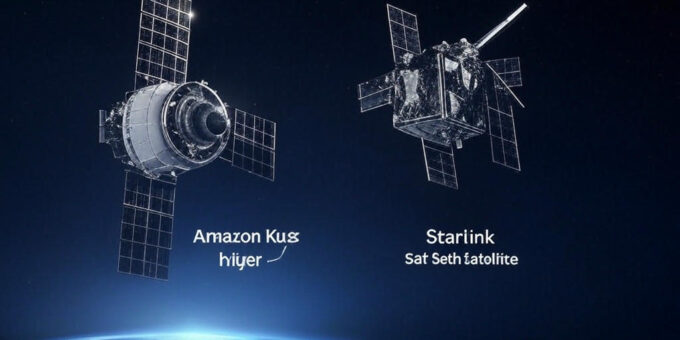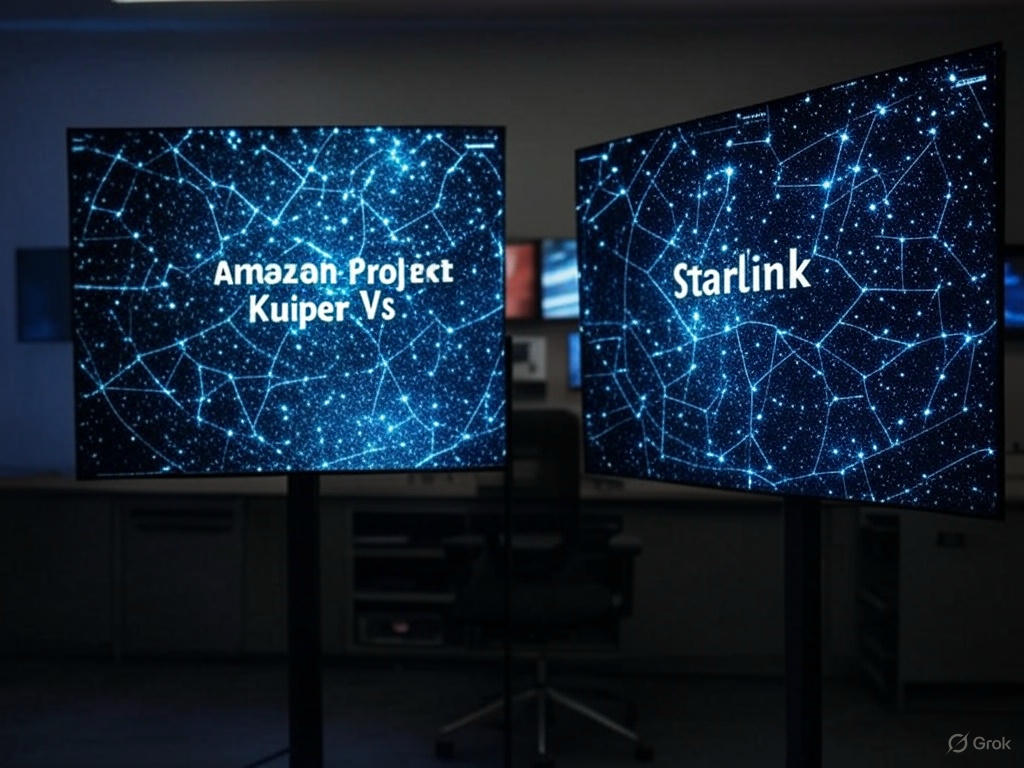
Amazon’s Project Kuiper and SpaceX’s Starlink are two big names racing to bring satellite internet to the world. Both promise fast internet for people in remote areas, but which one is better? In this article, we’ll compare Amazon’s satellite internet with Starlink using the latest data. We’ll look at speed, coverage, cost, and more to help you decide which service might work best for you. Let’s dive in and see how they stack up!
What Are Project Kuiper and Starlink?
First, let’s understand what these services are. Project Kuiper is Amazon’s plan to launch 3,232 satellites into low Earth orbit (LEO) to provide internet access worldwide. Amazon wants to help people in rural areas, where traditional internet like cable or fiber isn’t available. They’ve already launched two test satellites in 2023, and more are coming in 2025.
Starlink, run by SpaceX, is further along. It has over 6,000 satellites in orbit as of April 2025 and serves more than 5 million customers globally. Starlink started offering internet service in 2020 and has become popular for its fast speeds and wide coverage, even in hard-to-reach places like mountains or islands.
Both companies aim to bridge the digital divide—helping people get online for school, work, or fun. But they have different approaches, and the data shows some key differences.
Comparing Internet Speeds

Speed is a big factor when choosing an internet service. Let’s see how Amazon and Starlink compare.
Starlink Speeds
Starlink offers download speeds between 50 Mbps and 250 Mbps for most users, based on data from Speedtest.net in 2025. In some areas, speeds can reach up to 500 Mbps, which is great for streaming, gaming, or video calls. Upload speeds are usually 10 Mbps to 40 Mbps. However, speeds can vary depending on how many users are connected in your area. Latency, which affects how fast websites load, is around 20 to 40 milliseconds (ms)—pretty good for satellite internet.
Project Kuiper Speeds
Project Kuiper hasn’t launched its full service yet, but Amazon shared some early data from its test satellites. In trials, Kuiper reached download speeds of up to 400 Mbps, which is impressive. They also reported a latency of 20 ms, matching Starlink’s best numbers. Amazon says its advanced laser technology, which connects satellites to each other, will help keep speeds consistent even as more users join.
Speed Verdict
Right now, Starlink has more real-world data, and its speeds are proven to be reliable for millions of users. Project Kuiper’s test results look promising, but we’ll need to see how it performs once it’s fully launched. For now, Starlink has the edge in proven performance, but Kuiper could catch up.
Coverage and Availability
Coverage is another key area. Satellite internet is all about reaching places where regular internet can’t go.
Starlink Coverage
Starlink is available in over 70 countries as of 2025, including the U.S., Canada, Australia, and parts of Africa and South America. With 6,000 satellites, it covers most of the globe, though some areas, like parts of the Middle East, are still waiting for approval. Starlink also works on moving vehicles, like RVs and boats, which is great for travelers.
Project Kuiper Coverage
Project Kuiper isn’t fully operational yet, but Amazon has big plans. They’ve partnered with companies in South America, Japan, and Africa to bring internet to underserved regions. The FCC requires Amazon to launch half of its 3,232 satellites by July 2026, so coverage will grow over time. Amazon also plans to work with businesses first, like schools and hospitals, before offering service to regular customers later in 2025.
Coverage Verdict
Starlink wins on coverage right now because it’s already serving millions of users worldwide. Project Kuiper is still in the early stages, but its focus on underserved areas could make it a strong player in the future, especially in regions where Starlink isn’t available yet.
Cost and Affordability
How much you’ll pay is a big deal. Let’s break down the costs for both services.
Starlink Costs
Starlink’s equipment, like the satellite dish and router, costs $599 upfront for most customers. The monthly fee is $120 in the U.S., but it can be higher in other countries—up to $200 in some places. They also offer a cheaper plan called “Starlink Mini” for $50 a month, but the dish still costs $250. For businesses or boats, the equipment can cost $2,500 or more, with monthly fees starting at $250.
Project Kuiper Costs
Amazon hasn’t shared exact prices yet, but they’ve said they want to make Kuiper affordable. Some experts think the equipment might cost around $400, and the monthly fee could be $80 to $100, based on Amazon’s goal to compete with Starlink. Amazon also plans to offer discounts for schools and communities in need, which could make it more accessible.
Cost Verdict
Starlink’s costs are higher, especially for the equipment. Project Kuiper might be cheaper, but we won’t know for sure until Amazon releases its pricing. If Amazon can keep costs low, it could attract more customers, especially in developing countries.
Equipment and Setup
The equipment you need and how easy it is to set up can make a big difference.
Starlink Equipment
Starlink users get a satellite dish, a router, and a power supply. The dish is about 23 inches long and needs a clear view of the sky to work. Setup is simple—you just plug it in, point the dish at the sky, and connect to Wi-Fi using the Starlink app. The dish even has a motor to adjust itself automatically. However, some users say the dish is bulky, and it can be tricky to install in areas with lots of trees or buildings.
Project Kuiper Equipment
Amazon hasn’t shown its final equipment yet, but they’ve said their dish will be smaller and lighter than Starlink’s. Early designs suggest it might be as small as 11 inches wide, making it easier to install. Amazon also claims its dish will use less power, which could save money on electricity. Setup details aren’t available yet, but Amazon says it will be user-friendly.
Equipment Verdict
Starlink’s equipment is reliable and easy to use, but it’s a bit bulky. Project Kuiper’s smaller, energy-efficient design sounds promising, but we’ll need to see it in action. For now, Starlink has the advantage because its setup is already proven.
Reliability and Weather Impact
Satellite internet can be affected by weather, like rain or snow. Let’s see how these services handle it.
Starlink Reliability
Starlink works well in most conditions, but heavy rain or snow can slow it down. Users report occasional outages during storms, with speeds dropping by 20% to 30%. Starlink’s dish has a built-in heater to melt snow, which helps in cold climates. Overall, it’s reliable for most users, with 99% uptime in good weather.
Project Kuiper Reliability
Amazon says Project Kuiper will use advanced technology to handle weather challenges. Their satellites have laser links that can reroute data if one satellite is blocked by clouds. However, since Kuiper isn’t fully launched, we don’t have real-world data on its reliability. Amazon’s test satellites performed well in controlled tests, but storms could still be a challenge.
Reliability Verdict
Starlink is more reliable right now because it’s been tested by millions of users in all kinds of weather. Project Kuiper’s tech sounds advanced, but we’ll need more data to know how it holds up.
Environmental Impact
Satellites can affect the environment, like causing light pollution for astronomers or creating space debris. Both companies are working to reduce their impact.
Starlink has been criticized for making the night sky brighter, which makes it harder for astronomers to study stars. SpaceX has added sunshades to its satellites to reduce glare, but the issue isn’t fully solved. Starlink also has a plan to deorbit old satellites safely, reducing space debris.
Project Kuiper is taking similar steps. Amazon says 95% of its satellites will be removed from orbit within 10 years of their mission ending, following FCC rules. They’re also designing satellites to be less reflective. Since Kuiper has fewer satellites in orbit right now, its impact is smaller, but that will change as more launch.
Which Is Better for You?
So, is Amazon’s satellite internet better than Starlink? It depends on your needs:
- Choose Starlink if: You need internet now and live in an area where it’s available. Starlink is proven, fast, and reliable, though it’s more expensive.
- Choose Project Kuiper if: You’re willing to wait for a potentially cheaper option with advanced technology. Kuiper might be a better fit for schools or communities in need.
The data shows Starlink is ahead in speed, coverage, and reliability, but Project Kuiper could catch up as it launches more satellites. Keep an eye on Amazon’s progress in 2025 to see how it compares once it’s fully operational.
Conclusion
Amazon’s Project Kuiper and Starlink are both working to bring internet to the world, but they’re at different stages. Starlink is the leader right now, with faster speeds, wider coverage, and proven reliability. Project Kuiper shows promise with its test results and focus on affordability, but it’s not ready yet. If you’re deciding between the two, Starlink is the better choice for now—but Kuiper might be worth watching as Amazon ramps up its launches. Stay informed, and pick the service that fits your needs best!
